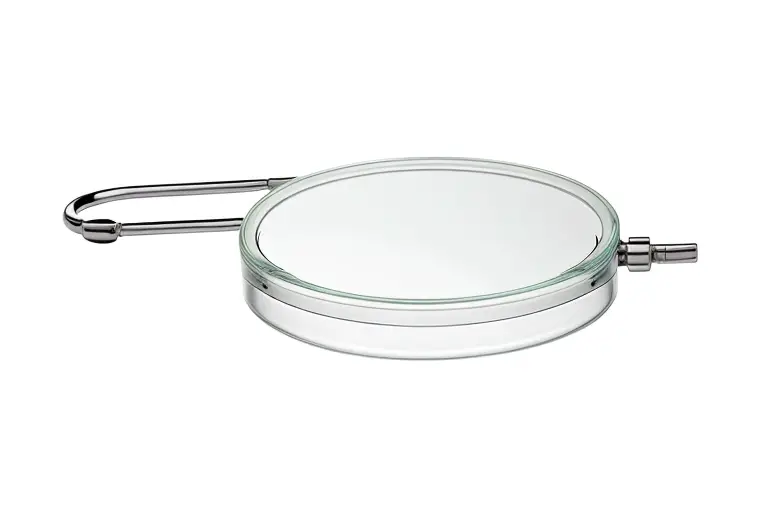In chemistry, a watch glass is a circular, concave piece of glass that is used as a beaker cover, a surface for evaporating liquids, and a container for solids to be held while being weighed.
Table of Contents

Types of Watch Glass
- Acrylic Crystal
- Mineral Crystal
- Sapphire Crystal
Acryl crystal
Acryl crystal is a type of Watch Glass in which sometimes referred to by the trade names “Hesalite,” “Perspex,” or “Plexiglass,” is just a specially made polymethyl methacrylate plastic that has been shaped to fit over a watch dial.
Because of their low retail price, flat chunks of acrylic crystal are frequently fitted to really cheap watches. Because this kind of glass is so easily manipulated, watchmakers can quickly manufacture domed glass, which looks attractive when viewed from an angle. This type of glass is also frequently used on retro-inspired timepieces. Overall, some people think acrylic appears better than others, while others find it to be cheap-looking.
Although acrylic glass is quite inexpensive, its flexibility makes it extremely resistant to impacts despite its softness making it highly scratchable. The aforementioned pseudonyms refer to specific varieties of acrylic glass that exhibit slightly varying characteristics but generally exhibit extremely comparable performance.
Pros:
- Resistant to impacts
- Easily removes minor blemishes with polishing
- Low price
Cons:
- Easily marked and scratched
- Numerous scratches may make the dial difficult to see.
- Some people believe it to be “cheap” looking (subjective).
For: Low cost watches, retro watches, practical dive watches.
Mineral Crystal
Mineral glass, is a type of Watch Glass which is made of silica, resists scratches better than acrylic crystal, yet it’s still not that great in my opinion. This has comparable qualities to the conventional “glass” that is in your windowpanes, making them nearly identical.
Because mineral crystal is inexpensive to produce and has some scratch resistance, it is frequently seen on “fashion watch” brands.
Pros:
- More resilient to scratches than acrylic
- Diminished compared to sapphire
- Quite resilient to impacts
Cons:
- Far less resilient to scratches than sapphire
- In most cases, repairs are not feasible for damaged items (such as broken, severely scratched, or chipped). a replacement crystal would be required.
- May fracture when struck
For: All-purpose, less expensive timepieces when sapphire is too expensive or unavailable.
Sapphire Crystal
Since sapphire is the hardest crystal on the market, it is frequently selected as the standard option for more expensive watches. For many people, sapphire is the best material for watch glass.
The majority of sapphire glass found in wristwatches is not the naturally occurring substance you may be familiar with, but rather synthetic (man-made) sapphire. Similar to acrylic, this is translucent crystallized aluminum oxide, which is often created in a laboratory, rather than actual “glass.” A sapphire crystal is difficult to scratch with anything other than a diamond fragment.
Sapphire is fairly prone to breaking if subjected to strong blows, despite its good scratch resistance. This is why some watch styles, like army watches, choose acrylic or other materials that are more resistant to breaking. However, it’s not as critical as you may think unless you plan to drop your watch on hard surfaces or wear it while performing a very manual work. I haven’t broken a sapphire crystal yet.
Pros:
- Superior resistance to scratches
- The color and appearance are appealing.
- Improved clarity of vision and anti-reflective coating nearly make this crystal “disappear.”
Cons:
- Increased expense
- Prone to breaking under strong impacts
- Repairs are typically not feasible for broken or damaged items; a replacement crystal would be required.
For: Expensive timepieces that don’t want scratches.
Other Glasses
Sapphire-coated mineral crystal
Sapphire-coated mineral glass is a relatively new concept that appears to be gaining traction among microbrands. This is just a piece of mineral glass that has been covered in a sapphire laminate. Seiko once employed a glass known as “Sapphlex,” which is a noteworthy specimen of it.
In my experience, this serves as a kind of intermediate material between sapphire and mineral. Though I’ve heard instances of the sapphire layer breaking off or separating from the mineral glass in severe cases, it’s frequently advertised as the best of both. That’s why I usually go for ordinary sapphire glass. The industry shifted away from the coated material as sapphire’s production costs dropped, which I believe tells something about the coating’s actual performance. Originally, this coating was offered as a more affordable option to sapphire.
Crystal Krysterna
The name “Krysterna” refers to a mysterious type of watch glass that is utilized by the Akribos subsidiary brand and the Stuhrling brand.
Regarding this substance and its performance, not much is known. Stuhrling markets this as the greatest material for a watch dial and makes many audacious claims. The claim that this glass is “more shatter resistant than sapphire crystal” is one of its main selling points, and it initially sounds plausible. Sapphire is the least shatter-resistant kind of glass, as previously demonstrated, so that doesn’t really tell us anything about how good Krysterna is.
Read on: Buffs Glasses
Uses of watch glasses
- As was already indicated, one common usage for a watch glass is as a beaker lid. Here, the container is positioned above a watch glass, which facilitates easier control and modification of the vapour saturation conditions.
- When weighing solids on a scale, a watch glass is frequently used as a container. A watch glass is placed on the scale before the necessary amount of solid is weighed. The scale is then tarred or zeroed so that just the weight of the sample substance can be measured.
- Solids can also be dried using watch glass. A watch glass is frequently employed when additional drying is necessary and a certain kind of solid needs to be separated from its somewhat volatile solvent. Spreading the substance on a watch glass, folded filter paper is frequently placed above to prevent the product from being contaminated by airborne particles.
- A watch glass can be positioned within a fume hood with sufficient air circulation for a sufficient duration of time to optimize the drying rate. Another method used in chemical labs to speed up the drying process is to gently spray nitrogen gas or dry air over the watch glass from an upside-down funnel that is fastened above it.




One thought on “Types Of Watch Glass – Which Is Best?”